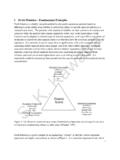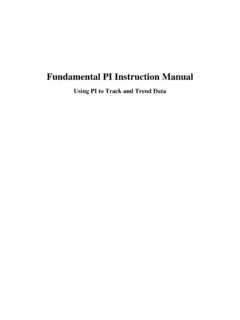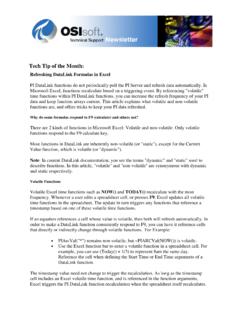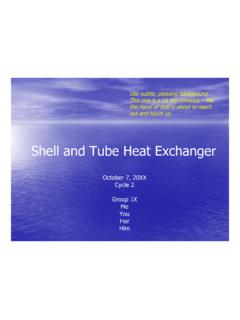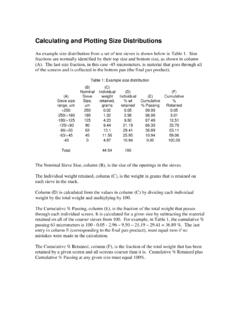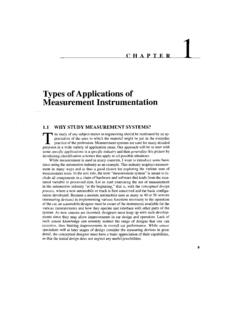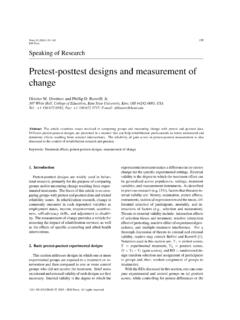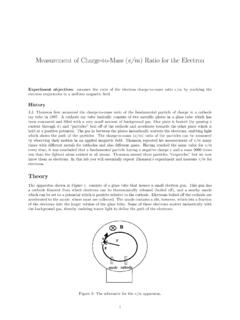Transcription of Introduction to Measurement, Error Analysis, Propagation ...
1 Introduction to measurement , Error Analysis, Propagation of Error , and Reporting experimental Results Pintar, Drummer, D. Caspary Department of Chemical Engineering Michigan Technological University Houghton, MI 49931 September, 2013 Overview Experimentation involves the observation and measurement of a physical property or a characteristic of something. A fundamental rule of scientific measurement states that it is never possible to exactly measure the true value of any characteristic, only approximations of the true value. For this reason, it is the responsibility of the engineers and scientists to report all measured values along with an estimation of the uncertainty in the measurement .
2 The process of estimating the true value of the measurement and its associated uncertainty is called Error analysis. Furthermore, when a measured value is reported directly, the Error analysis is complete when the Error associated with that value is estimated and reported. In other cases, the measured value is to be combined mathematically with other measured values and the calculated result is the final reported value. In this case, the errors associated with each measured value must be combined to estimate the uncertainty in the result. This additional calculation is called Propagation of Error . This paper presents a procedure for Error analysis and Propagation of Error for use in Unit Operations Laboratory reports.
3 Sources of measurement Error 1. Human Error : This is also referred to as Gross Error . Careful planning and execution of your experiment should prevent mistakes. 2. Reading Error : This is a combination of the instrument s accuracy and precision and can be found in the manufacturer s specifications for the instrument. a. Accuracy refers to an instrument s ability to measure the true value of a characteristic. This describes how close the measurement is to the true value. b. Precision refers to the randomness of the measured value due to variation in the measuring device. This describes the repeatability of the measurement . c. Reading Error is treated under the general categories of Systematic Error and Random Error .
4 3. Systematic Error : This is sometimes called determinate Error . a. Has the same sign and magnitude for identical conditions; systematic Error is predictable. b. Sources of systematic Error : i. Mis-calibration of instruments. This class of systematic Error refers to the instrument s accuracy. Could be due to a zero offset or improper instrument span. ii. Natural phenomena or inherent characteristics of the instrument. Could be due to hysteresis or the linearization of a non-linear response, or could be due to the method used, measuring surface temperature of a pipe to represent fluid temperature. iii. Consistent operator Error , parallax. c. Often can be removed or compensation made: i.
5 Recalibration, adjusting zero and span 1ii. Correction factors or calibration curves iii. Improved procedures iv. Comparisons to other methods. d. Must be corrected before data are reported or used in subsequent calculations. 4. Random Error : This is a combination of the randomness of the measurement process and the randomness of the characteristic you are measuring. It is also called indeterminate Error . a. Can be positive or negative and has varying magnitude, is not predictable. b. You can not differentiate the source of the fluctuations caused by the measuring instrument from those of the process itself. c. Sources of random Error : i. Random process fluctuations.
6 Equipment goblins , moon phase, miscellaneous ii. Random instrument fluctuations (referred to in the instrument manufacturer s data sheet as instrument precision) iii. Degree of subdivision of instrument scale and your ability to precisely read the scale d. Random Error is quantified using Statistical methods. Uncertainty in Values Obtained from Empirical Relationships Oftentimes you will be comparing your measured values with values calculated from empirical relationships. These empirical values will also have an Error (or uncertainty) associated with them. Theoretical values for friction factors, heat transfer coefficients, mass transfer coefficients, etc. are usually obtained from correlating equations and diagrams and have an often overlooked Error referred to as engineering accuracy.
7 Unless the specific reference states otherwise, engineering accuracy can be assumed to be in the range of 10-20%; therefore, using a 15% uncertainty is recommended. experimental Planning and Data Collection Activities With many of the experiments in Unit Operations Lab you will be asked to measure a unit operation s performance at several different steady state conditions. To report the result at each steady state, you will collect data for two reasons. First, you will verify that the unit operation is at steady state. Second, you will make a number of repeat measurements at this steady state at regular, predetermined time intervals so that you can predict the true value of each measurement and estimate its associated Error .
8 An important first step in planning experimental work is to identify what the experimental results should look like. From there, determine what needs to be measured and how it should be measured. In many cases there are choices in the type of measuring instrument you could use. Quite often, an instrument or method that yields high precision measurements takes more time or effort to use. Using trial calculations, determine the effect of that instrument s precision on the final calculated results and select an appropriate instrument. Instrument precision can usually be obtained from the manufacturer s data sheet. This value is your reading Error and should be recorded in the laboratory notebook along with the model and serial number of the device long before you start any lab work.
9 Another step in the experimental planning process is to determine the number of replicates required to characterize each measurement and the measurement s uncertainty. An infinite number of replicates can be averaged together to report the true value of the measurement exactly. Time, resources, and other practical limitations prevent this. So, determine how many replicates you will need in order to characterize the measurement . Minimally, it takes 2 replicates to calculate a standard deviation. However, be aware that a standard deviation calculated around 2 or 3 replicates 2has little or no meaning and will result in a large associated uncertainty. Five values should be considered as a minimum.
10 Finally, check that the data gathering activities fit within the scheduled laboratory time. Before starting any experimentation on lab day, it is your responsibility to verify that measuring instruments are properly calibrated. If possible, two-point or three-point calibrations are performed. For example, a temperature device can be placed in an ice bath, checked at room temperature, and in boiling water to verify the calibration; or several standard solutions can be carefully prepared and the sensor range checked at these known points. Record any zero or calibration offsets in your laboratory notebook. Prepare a calibration curve if necessary. Add appropriate columns in your spreadsheet to correct measured values.
